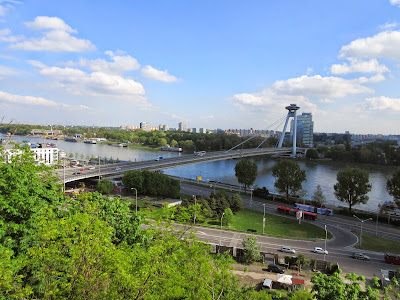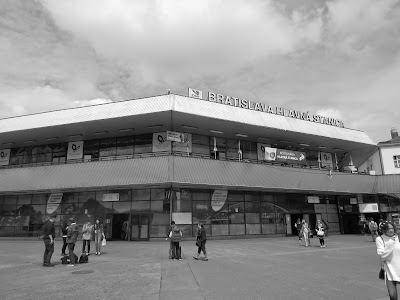When Czechoslovakia split in 1993, many people imagined they
saw two new countries form out of a former Austro-Hungarian and former Soviet
satellite. However, Slovakia was once
its own independent
country well within the 20th century. In 1939, when Nazi Germany ceded the
Sudeten territory of Czechoslovakia without that country’s consultation,
Slovakia declared its independence on March 14, 1939. The new leader, Tiso, was elected as
president, but he was opposed by a group of Nazi radicals known as the Hlinka
Guards. Mediated by the Reich, the
Hlinka guards and the Slovak Populist Party shared power, but Slovakia began to
adhere to Nazi policies, including establishing a “Jewish Code” and investing
development in arms productions for the Nazi war cause. Only in 1942 did a sizeable resistance groups
of Slovaks fight against the Nazis, and Slovakia welcomed liberation by the
Soviet army in 1944, later to be joined again with the Czech Republic as
Czechoslovakia.
How did Czechoslovakia split again? According to Tony Judt’s “Postwar: A History
of Europe Since 1945”, independence for both nations from Czechoslovakia was
won through a failed game of chicken.
After the Velvet Revolution brokered freedom for these two countries
from the Soviet Revolution, sharing power between the Czechs (2/3 of the
country) and Slovaks (the remaining 1/3) was a contentious issue. Based on their first agreement upon
independence, both halves of Czechoslovakia agreed to split power in government
equally, which quickly seemed unfair to the more populous Czechs. Therefore, both governments threatened
independence from each other unless one side gave ground. In 1992, Slovak parties in government were
able to vote for a declaration for Slovakia as an independent state, and in the
winter Czechoslovakia was dissolved, even though polls indicated that the
majority of the population (of all of Czechoslovakia) opposed independence. Throughout much of the Soviet period,
Slovakia was much less developed than the Czech Republic. However, after joining the Schengen zone,
Slovakia reached growth rates that were some of the highest on the continent before
the financial crash in 2008.
During this trip, Slovakia was a minor detour between my
travels from Vienna to Budapest.
Bratislava was only about an hour’s train ride away from Vienna. Despite the short distance, the development
between Vienna and Bratislava was stark.
It goes without saying that Bratislava certainly felt more “communist”
than Vienna. However, I was always
surprised that Bratislava lacked so many Germans despite its proximity to one
of the largest German-speaking cities in the world. Partly what explains this is that, immediately
following the end of WW2, about 12 million Germans were forced out of or fled
Eastern Europe, and relocated to Germany or Austria. Many of these Germans had migrated through
Europe, to places like Romania, the Baltics, and Hungary, many times through
trade networks including the Hanseatic League.
For example, the ethnic composition of Bratislava in 1880 was estimated
to comprise of 2/3 Germans, and just before WW2 that makeup fell to 20%. However, after the expulsion of Germans from
Czechoslovakia in the 1940s, Bratislava was about 95% Slovak.
I arrived to Bratislava on May 2, and the walk to from the
train station was pleasant, if not eerily people-less. After finally finding my hostel, I navigated
through the old town and climbed the hill where a (relatively) newly renewed
castle stands. The view over the Danube
river was beautiful, and it was great to escape some of the tourist crowds that
were typical of Vienna. But after
summiting to the castle (the original was supposedly accidentally burned down
by Italian soldiers stationed there during the time of Austria-Hungary), I
immediately discovered that Bratislava lacked a good deal of attractive tourist
attractions.
But what Bratislava lacked in historical or cultural
emblems, it had in soul. The old town,
with streets and charm dating before Communist times, were pretty and
unassuming. The food was also delicious
and hearty, and I was able to dine on their national dish, the bryndzové
halušky, which is basically gnocchi with cheese and bacon. I was also floored by the wide variety of
choices of rakija, including brandy made from pears, cherries, and plums (known
in Bratislava as slivovitz). In many
ways, Bratislava reminded me of a hypothetical Macedonia that could be
developed after a decade in the European Union.
Which is a good thing since Bratislava seems to be the new, hottest
tourist destination for Brits from London.
 |
| Arriving by train in Bratislava |
 |
| Reunited with the Danube |
 |
| The Castle |
Now that Wizz Air has cheap flights between London and
Bratislava, many Brits choose Bratislava as a cheap weekend getaway. Slovaks joke that it is great that people
from London flock to their country to get drunk at half-price. When I returned to the hostel after dinner, I
encountered a hostel room full of sleeping blokes. One woke to greet me friendly, and invited me
to join his group for a Pub Crawl that would tour some of Bratislava’s
pubs. Even though the tour guide for the
pub crawl did not show up, we decided to jump from pub to pub, keeping 2 Euro
pints as our price factor. Eventually,
we ended at a club call Prijatelji (or the Slovak form of the word “friends”),
which looked like a smoky (it is alright to smoke in most Slovak
establishments) 1990s hotel lounge/ bank lobby.
The next day, I found a quaint Catholic church in the old town for mass, adding Slovak to the list of languages through which I received the word of God.
Even though I spent only one night in Bratislava, it was
great to see a city that was full of life.
Slovakia seems to be destined to be forgotten by history (as the hostel
host confirmed, most foreigners associate Bratislava with the movies “Eurotrip”
and “Hostel” over anything else). But
like Macedonia, Slovakia is a landlocked country, shadowed in history by larger
powers, that continues to live on with its own traditions and spirit. I just wish I had more time to visit
Slovakia, and I hope more people have the will to visit it as well.
 |
| Probably some of the best beer I had all trip |
 |
| On the main promenade |
 |
| Slivovitz and Cabbage Salad |
 |
| On our self-made pub crawl |













No comments:
Post a Comment